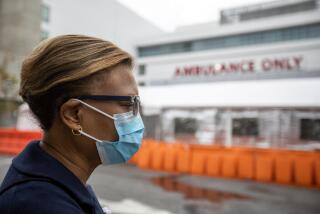Recession is squeezing life out of many money-strapped hospitals
- Share via
Gainesville’s first community hospital has been on life support ever since Shands HealthCare system in northern Florida bought it a dozen years ago.
Now, because of the recession, the plug is being pulled on money-losing Shands AGH. This fall, its nonprofit parent company will shut the 80-year-old, 220-bed hospital and shift staff and patients to a newer, bigger hospital nearby in an effort to save $65 million over three years across the eight-hospital system.
Like many of the nation’s hospitals, Shands HealthCare is being squeezed by tight credit, higher borrowing costs, investment losses and a jump in the number of patients -- many recently unemployed or otherwise underinsured -- not paying their bills.
All that has begun to trigger more hospital closings -- from impoverished Newark, N.J., to wealthy Century City -- as well as layoffs, other cost-cutting and scrapping or delaying building projects.
More closings and mergers are on the way, industry consultants predict.
“They’ll get swallowed up by somebody else, if they need to exist; and if they don’t, they’ll just close,” said Tuck Crocker, vice president of the healthcare practice at management consulting firm BearingPoint.
Hospitals, which employ 5 million people, are reporting that donations and investment returns are down, patient visits are flat, and profitable diagnostic procedures and elective surgeries are declining as people with inadequate insurance delay treatment. Many of those patients eventually turn up in emergency rooms, seriously ill, making it tough for hospitals to lay off doctors and nurses.
Those problems are aggravating long-standing stresses: stingy reimbursements from insurers, even-lower payments that generally don’t cover costs for Medicare and Medicaid patients, and high labor and technology costs.
Hospital executives and consultants say the growing number of people with high-deductible health plans is boosting unpaid patient bills. Many worry that health reform efforts by the Obama administration could bring cuts in Medicare reimbursements, and many cash-strapped states already have begun cutting payments for people covered by Medicaid.
In the last few months, patients and insurers have been paying hospital bills more slowly. As a result, some think hospitals will start demanding up-front payments for elective procedures.
Tim Goldfarb, chief executive of Shands HealthCare, said his system, Florida’s second-largest provider of charity care, in 2008 has seen bad debt jump 20% because of uninsured patients.
“We write them off,” he said. “It’s a burden that we cannot carry any longer.”
Florida started cutting Medicaid reimbursements two years ago when its economy started to slow, Goldfarb said. He fears another huge cut this year.
Shands already has paid off variable-rate bonds to avoid higher interest rates, deferred roughly $25 million in equipment purchases, shifted management meetings to church halls and adopted employee suggestions to save millions more. Goldfarb believes closing Shands AGH will save nearly $100 million over seven years, mainly by avoiding costly renovations.
Around the country, while some hospitals still are doing well, closings and bankruptcies seem to be picking up.
Financially troubled Century City Doctors Hospital gave up hope of finding a buyer and closed in August. The 176-bed facility, in the Century City Medical Plaza, had struggled to pay its growing debt, which the hospital had estimated at more than $60 million.
And in New Jersey, where 47% of hospitals posted losses in 2007, five of the 79 acute-care hospitals closed this year; a sixth may close soon.
Many of the nation’s hospitals are cutting costs by outsourcing services like housekeeping and security and trimming staff through layoffs, hiring freezes and attrition. Most are trying not to touch patient-care jobs -- nurses, pharmacists, therapists and X-ray technicians -- because those already have staff shortages.
Rich Umbdenstock, CEO of the American Hospital Assn., said some of the hardest-hit hospitals began reducing staffing and services as early as last spring, and more will follow. He expects some to eliminate money-losing services such as behavioral health treatment or those with high operating costs such as burn units.
An association survey of more than 700 hospitals found that two-thirds have seen elective procedures and overall admissions fall since July.
An industry database on more than 550 hospitals found that their third-quarter investment results amounted to a combined loss of $832 million, down from a $396-million gain a year earlier. During the quarter, those hospitals paid 15% more in borrowing costs and swung to a 1.6% average loss, from an average 6.1% profit margin a year earlier.
“They’re having serious problems getting the capital they need for needed renovations and upgrading their facilities,” said Mike Rock, a lobbyist at AHA, which is seeking increased federal reimbursements from Medicaid and Medicare.
In November, Moody’s Investors Service changed its 12- to 18-month outlook from “stable” to “negative” for nonprofit and for-profit hospitals, citing “prospects of a protracted recession,” bad debt and the credit crunch.
“Looking forward, the cost of borrowing will likely be higher -- and may be nonexistent for lower-rated hospitals,” Moody’s noted, a problem because hospitals borrow for everything, including expansions, equipment, payroll and supplies.
More to Read
Sign up for Essential California
The most important California stories and recommendations in your inbox every morning.
You may occasionally receive promotional content from the Los Angeles Times.










